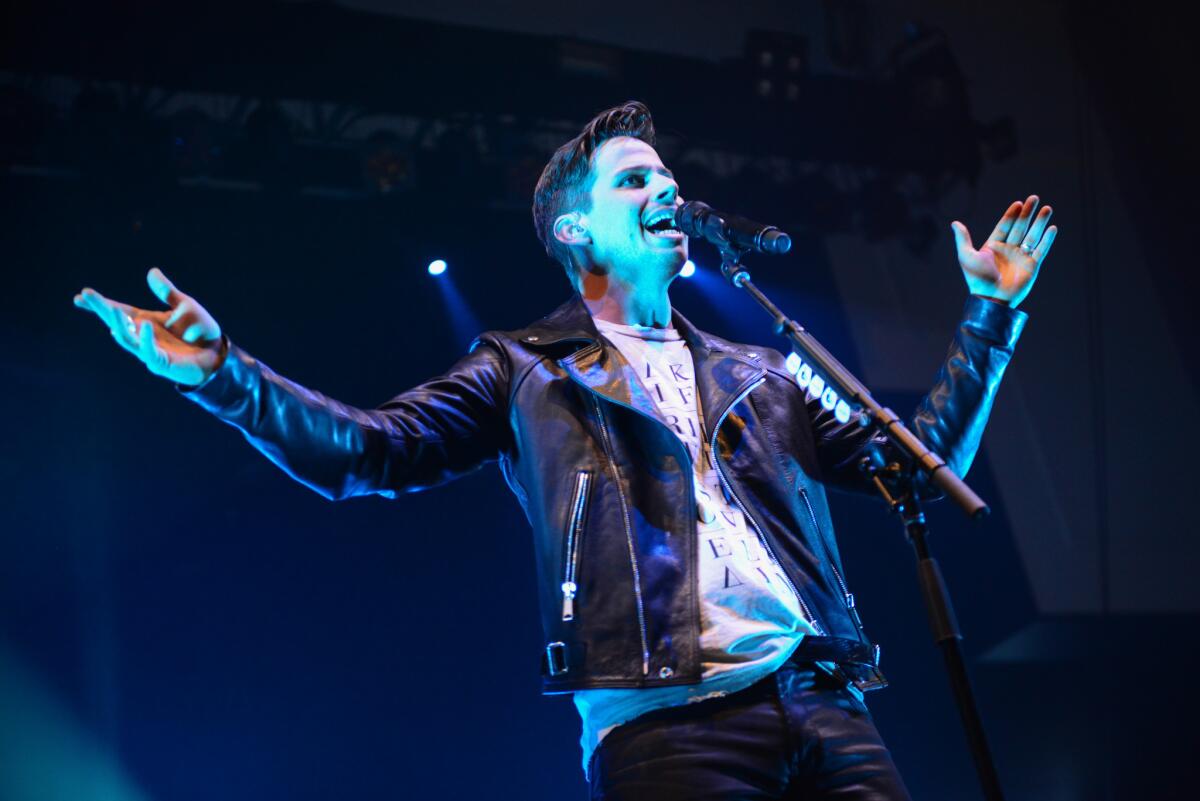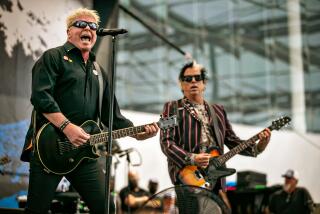Foster the People goes political with ‘Supermodel’

In 2010, Foster the People’s Mark Foster lived the dream for an aspiring songwriter.
Buoyed by a light-stepping danceable beat, “Pumped Up Kicks” was electronic bubble gum pop with a dark lyrical undercurrent and a carefree tone that quickly went viral and was inescapable in summer 2011. It would go on to sell 5.3 million downloads in the U.S., according to Nielsen SoundScan.
Then came the fear. “I have been afraid of the sophomore slump since before our first record even came out,” Foster says.
The dread existed even as the band was awash in good fortune. “Pumped Up Kicks,” Foster admitted in 2011, “rolled out the red carpet for us,” earning the trio a management deal after it had played only about six shows. A debut album, “Torches,” would eventually sell more than 1 million copies and reach No. 1 on Billboard’s rock albums chart, bringing with it a bit of dance culture to modern rock radio.
Despite efforts to control a phenomenon, such as purposefully booking the band in smaller venues than were offered, Foster the People took off quickly. “It was almost harder for them,” says co-manager Brett Williams of Los Angeles-based Monotone Inc. “You had to fight against how fast it was going.”
Two years of aggressive touring would include a high-profile appearance at the 2012 Grammy Awards with the Beach Boys. All of this was delaying the inevitable, nagging question: How does a band marked by instantaneous, social-media-driven success write not just a second album but one that proves the group has staying power?
“I have seen so many bands that I love fail on their second record. I couldn’t listen to the fear that I had to have a song be a follow-up to ‘Pumped-Up Kicks,’” Foster says. MGMT, an electronic-focused pop band Foster the People has long been compared to, had a breakout album with 2008 hits such as “Electric Feel” and “Kids” but has seen its audience become increasingly niche since.
“There was pressure,” Foster says, “from what my fans would want to hear next. There was pressure from what the label would want to hear next. There’s pressure from what our non-fans are going to want to hear next — the voices of skeptics. I tried to leave all that at the door.”
INTERACTIVE: Discover songs of L.A.
Indeed, there is no clear successor to “Pumped-Up Kicks” on Foster the People’s “Supermodel,” which debuted Wednesday at No. 3 with 54,000 copies sold on the U.S. pop charts. The band, one of the top-billed groups at the Coachella Valley Music and Arts Festival coming in April, still genre-hops among pop, dance and rock with effervescence, but the lyrical concerns are of the worldly, sociopolitical variety. British punk band the Clash, namely the group’s disco-tinged and reggae-focused triple album “Sandinista!,” is cited by Foster as a primary influence.
Foster says he’s now uncomfortable with the very facets of modern pop-culture that made him a star and turned his band into an overnight success story. In turn, Foster has moved away from the more storytelling approach that marked the songs on “Torches,” singing now about “dissidents with the fire” who will “rip apart the marrow from the bone of the liars.”
“For me, a lot of the record is about Western culture, consumerism and the ugly side of capitalism,” Foster says. “I don’t want to hit you over the head with it, but those are the major topics. One thing I find really interesting is our worship of celebrity or politicians. We love to put people on pedestals. Look at reality shows. These people become giant stars. I find that fascinating. ‘Supermodel,’ for me, represents the age we are living in.”
Recorded largely in Morocco with Adele collaborator Paul Epworth, the Columbia Records release boasts Afro-Cuban rhythms, falsetto choirs and playful electronic effects.
Guitars rather than synths are up front, and although Foster the People still graces its tunes with friendly electro-pop beats, now a track is more likely to be thrown for a loop with disarming banshee howls — or samples of monkeys. Topicly, self-doubt and helplessness abound, as in the spry single “Coming of Age.” The album-opening “Are You What You Want to Be?” sets a fast-moving tribal beat, within which Foster wrestles with class concerns.
“Before the band took off, I lived a quiet life,” says the 30-year-old downtown resident, who at age 18 moved from Cleveland to Los Angeles to pursue a music career. “I lived in a one-bedroom apartment with no kitchen. I lived paycheck to paycheck. Then suddenly my life changed. We had people helping us. We had money. We could see the world. I traveled and saw how other people lived, and it left me brokenhearted.”
“I felt guilty for how my life had changed,” says Foster.
Foster says this outside the rooftop penthouse of the Santa Fe Lofts, the historic core building that now features a seven-story mural depicting the artwork for “Supermodel.” The mural exists in part to promote the new album and in part because Foster says he wants to “communicate something outside of music.” It’s a psychedelic drawing by visual artist and musician Young & Sick, and it features a high-heeled model vomiting a poem while paparazzi click their cameras.
It’s also representative of Foster the People’s ambitions. The band, rounded out by Cubbie Fink on bass and Mark Pontius on drums, wants to do pop-art but on a grand, easily accessible scale. When it comes to creating a 125-foot-by-150-foot mural, Foster claims ignorance at its cost (“I don’t deal with numbers,” he says), but getting it constructed wasn’t easy.
“Suddenly,” says co-manager Williams, “there’s a guy across the street who has a building who says you’re somehow disrupting his business, so you have to give him some money. Then there’s a guy who lives across the street who said our lights were too bright, so you have to give him [money]. Then there’s the parking lot. There was a lot of that.”
Foster, for his part, discusses the mural only through the lens of altruism. The artist takes a moment to lean in and contemplate each question, but once the words come he speaks in an excitable rush that takes a big-picture approach. Ask, for instance, about the mural’s inspiration for the mural, and he expresses concern that school art programs are losing funding.
FACES TO WATCH: Pop music and jazz
“Our country is losing touch with the idea that art is a vital and important part to the evolution of a society,” Foster says. “Art plays a huge role as to how a culture develops. When you cut the knees off of art, there’s no way to even articulate the long-term ramifications that has on a culture. I just want people to be more creative. I want someone to look at that wall and go, ‘Wow, that’s awesome. I’m going to go draw.’”
That earnestness comes through on “Supermodel,” which is ultimately optimistic. “The Truth” could be an Elton John-inspired empathetic ballad, only here it’s broken up with a smattering of digital rhythmic shakes and scrapes. “Pseudologia Fantastica” is all brightly colored soundscapes, with layer upon layer of fantastical synths beneath Foster’s sun-beaming vocals.
Foster says the band didn’t write any lyrics before going into the studio with Epworth, who, via his manager, declined an interview request. The group wanted to capture a sound Foster described as “Afro-beat, but mixed with ‘70s punk.” Directly ask him about the record’s sound and Foster gets more abstract. “If ‘Torches’ were a color it would be yellow,” he says. “This record would be blue.”
But does “blue” sound like another hit? While no one expects Foster the People to match the runaway success of “Pumped Up Kicks,” “Torches” spawned singles — “Helena Beat,” “Don’t Stop (Color on the Walls)” and “Houdini” — that each sold more than 250,000 downloads. Combined, the first three singles from “Supermodel” haven’t yet sold 200,000 downloads.
No matter, Foster says. Today his concerns are different.
“I went to India, I spent some time in the Middle East and I went to Northern Africa — places where the priorities are completely different,” Foster says. “Those cultures aren’t focused on individuals. They’re focused on communities. That changed how I will look at life. I saw people who had joy and human connections and they don’t have one one-thousandth of the things we have here.”
“But they have something we don’t have,” Foster continues, “a sense of community.”
More to Read
The biggest entertainment stories
Get our big stories about Hollywood, film, television, music, arts, culture and more right in your inbox as soon as they publish.
You may occasionally receive promotional content from the Los Angeles Times.







